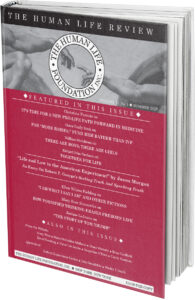Death as the Way to Life
This coming Thursday, Christians celebrate Jesus giving to his Church the sacrament of his body and blood. The Holy Eucharist is both a remembrance and a proclamation of his death. Both are included in the earliest reference we have to the Holy Eucharist, from a letter of St. Paul: “. . . the Lord Jesus . . . took bread . . . and said, ‘This is my body that is for you. Do this in remembrance of me’ . . . and also the cup . . . saying ‘This cup is the new covenant in my blood. Do this . . . in remembrance of me.’ For as often as you eat this bread and drink this cup, you proclaim the death of the Lord until he comes.” (I Corinthians 11: 23-26)
The tradition that St. Paul received, and then passed on, is that the Lord commanded his apostles to consecrate the bread and wine in remembrance of Him—which means, as a memorial sacrifice—a corporate act of worship, not just a mental recalling. That is the religious sense of the Greek word anamnesis, which translates as “remembrance.” Then, St. Paul continues, “. . . as often as you eat this bread and drink this cup, you proclaim the death of the Lord until he comes.” Not remember but proclaim! And “proclaim” translates the Greek word kataggelo (from which we have “evangelist”), which has the sense “to publicly and formally make something manifest.”
St. Paul is telling us that Jesus intended to give his Church a sacramental liturgy, a sacrifice, a “new rite” to replace the old, by which to offer thanks and praise to God the Father for his death. The actions, the dramatic gestures of the Eucharistic liturgy—taking, blessing, and distributing bread that is his body and wine that is his blood—were to ritually re-present his death and to proclaim its power to save. “Do this,” Jesus said, which means perform this liturgy. Of all the commandments he gave his disciples, this has been the one most perfectly obeyed.
We do what he commanded in the midst of a world that makes of death something very different from what Jesus makes of his death in his gift of the Holy Eucharist. Apart from the death of Jesus, the reality of death can only be a shadow darkening the world: at best, a mystery to be pondered and a reason to mourn; at worst, a threat to gain or maintain power; an instrument of terror; a way to prevent or escape from suffering; or, in the case of euthanasia or abortion, a means to dispose of inconvenient persons.
The brute and universal fact of death cannot simply be accepted; it must be given some kind of significance, minimal as that may be in a world that tries to do without God. At the least, death signifies our finiteness, reminding us that we are not God. But the prospect of death makes us accountable for the way we live, and what we live for—either egocentrically, for self, or altruistically, for others. But in either case, apart from faith in Jesus, death is simply loss, to self or to the world.
The gospel for Holy Thursday shows us the Lord Jesus investing his coming death with maximum significance when he “began to wash the disciples’ feet.”
He is making this domestic ritual—this humble service of a host to his invited guests—a sign of his divine self-giving love and his determination to engage us in his way of living, even unto death and beyond death. St. John prefaces this scene by writing that Jesus “loved his own in the world and . . . loved them to the end”; and as the end approached, he “was fully aware that the Father had put everything into his power and that he had come from God and was returning to God.” (John 13: 1-3)
Our Lord’s taking the form of a slave to wash the feet of his friends was more than a sign of self-abasement; it was a sign of love and communion—his desire for them to be united to himself in death and life, as he said to Peter: “Unless I wash you, you will have no inheritance with me.” (John 13:8) Earlier, John’s gospel put the same point in Eucharistic terms: “. . . unless you eat the flesh of the Son of Man and drink his blood, you have no life in you; he who eats my flesh and drinks my blood has eternal life, and I will raise him up at the last day. ” (John 6:53-54)
Christians celebrate the death of Jesus as something he invites us to partake in: He invites us to lay down our lives with and in his life, since the Holy Spirit makes us one with Him. This, which we accept in faith each time we say “Amen” to his body given for us and his blood poured out for us, forever alters the way we Christians think of death.
No longer is death for us the shadow darkening the world; or the end of our ambitions and our loves. No longer may we use it as a threat or a solution. We look to our own dying, not as an abridgement but as a consummation, not as a boundary, but as a passage; not as the end, but as the way to life.
The poet John Donne, the dean of St. Paul’s Cathedral, died in London in 1631. A few weeks before dying, he had his effigy carved on a funerary urn, a standing figure wrapped in a burial shroud, only his face showing, with eyes closed and a half-smile, as though waiting for Jesus to summon him to life. As one critic said, “[Donne] was . . . not a man [to take] death (literally) lying down, and was especially keen to make something exhibitive and performative out of [it].” He wrote many sermons, meditations, and some poems about death in Christ. Here is the most famous of them:
Death, be not proud, though some have called thee
Mighty and dreadful, for thou art not so;
For those whom thou thinkst thou dost overthrow
Die not, poor Death, nor yet canst thou kill me.
From rest and sleep, which but thy pictures be
Much pleasure; then from thee much more must flow
And soonest our best men with thee do go
Rest of their bones and soul’s delivery.
Thou art slave to Fate, Chance, kings, and desperate men,
And dost with poison, war, and sickness dwell,
And poppies or charms can make us sleep as well
And better than thy stroke. Why swellst thou then?
One short sleep past, we wake eternally,
And death shall be no more; Death, thou shalt die!









